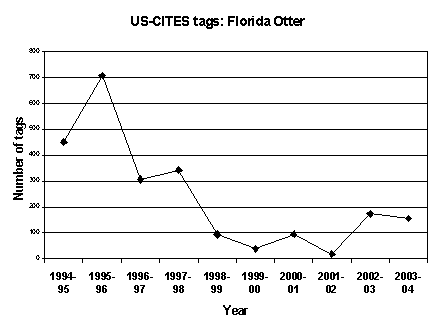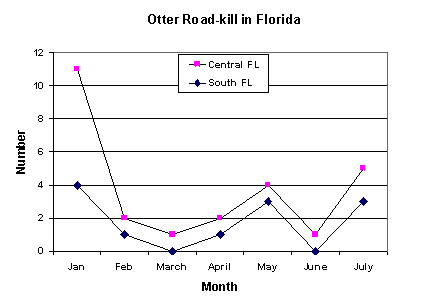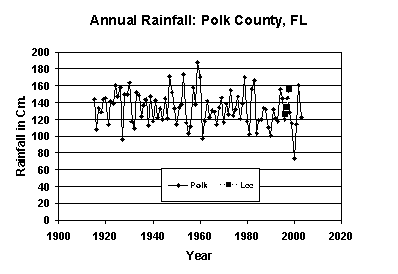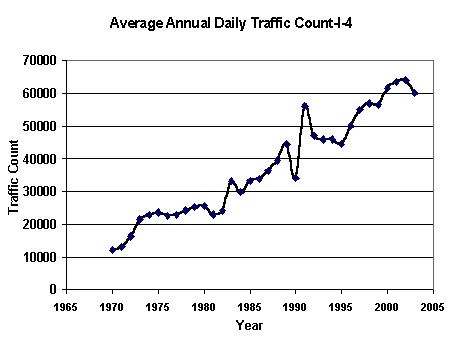 |
Last Update:
Thursday November 22, 2018
|
| [Home] |
|
Volume 21 Issue 2 Pages Pages 60 - 101 (January 2005) Citation: Kinlaw, A. (2004) High Mortality of Nearctic River Otters on a Florida, USA Interstate Highway During an Extreme Drought . IUCN Otter Spec. Group Bull. 21(2): 76 - 88 High Mortality of Nearctic River Otters on a Florida, USA Interstate Highway During an Extreme Drought Al Kinlaw PO Box 110430, Dept. of Wildlife Ecology and Conservation, University of Florida, Gainesville, FL 32611-0430, USA (received 20th January 2005, accepted 24th January 2005)
INTRODUCTION The Nearctic river otter (Lontra canadensis lataxina) occurs throughout Florida (HALL 1981, BROWN 1997) and is currently classified as a protected furbearer that can only be taken, according to Florida Administrative Code 68A-24.002 (2) (C), "from December 1 through March 1 by live traps, guns, dogs or snares." Historically, Florida's wetlands have been very productive in output of otters. In 1960-61, this state was third in the United States for otter harvest, with a total of 1435 animals in the hide dealers' reports. This figure was probably an underestimate, since hide dealers' reports do not indicate the true fur catches. One hide dealer indicated in an interview with MCDANIEL (1963) that he bought 4,500 hides in 1961-62 when 2,779 were reported in the hide dealer reports. Abundance of this semi-aquatic mammal in Florida was reported to be lowest in freshwater marshes, intermediate in salt marshes, and highest in swamp forest (HUMPHREY and ZINN 1982). However, the tremendous loss of wetlands (56 percent between l936 and l987) in Florida (KAUTZ 1993) has undoubtedly decreased populations. No statewide surveys have ever been conducted, thus there is little reliable information regarding the distribution, density, or mortality factors of otter in Florida. The only data available is the number of CITES (Convention on International Trade in Endangered Species of Wild Fauna and Flora) tags issued each trapping season which shows a dramatic decline (pers. comm. KURT HODGES, Florida Fish and Wildlife Commission, Fig.1); however these data may reflect marketplace trends rather than population trends of river otters.
The relative importance of road-kill compared to natural mortality factors of otter is not clear due to the obvious sampling bias involved, since road-killed carcasses are often available for examination but carcasses of animals that die in the wild are rarely discovered. In Europe, road mortality has been reported in a number of studies to be the predominant cause of non-natural mortality for the Eurasian otter Lutra lutra (see references in PHILCOX et al., 1999). Fifty-five out of a sample of 113 otters in Shetland, England, were killed on roads (KRUUK and CONROY 1991), with animals of all ages affected randomly. PHILCOX et al. (1999) reported a rapid increase in the number of otters killed on English roads since 1983, and that the busier "Trunk" or A roads (comparable to Interstate highways in the US) accounted for 57% of the incidents, but only comprised 13% of the road network. Likewise, MADSEN (1996) reviewed data from European otters killed by cars and concluded that the most dangerous kinds of roads for otters are highways or primary roads that are wider than 6 m with a relatively high traffic density and speed. KÖRBEL (1994) showed that regional roads with a higher volume of traffic made up only 9.5% of the road system in Germany but accounted for 60.7% of the otter roadkills. In the United States, the impact of roadkill on otters has only been reported as supplemental data. MELQUIST (1981) reported roadkill as the single most important mortality factor in his study, accounting for 3 out of 9 fatalities. LARIVIÈRE and WALTON (1998) asserted in their review that most Lutra mortality is human-related, listing roadkill along with trapping, illegal shooting, and captures in fishery nets. In Florida, the evidence is clear that vehicle collisions have negatively impacted many species in a density independent fashion, including the highly endangered Florida panther (Puma concolor coryi), Florida key deer (Odocoileus virginianus clavium), and the American crocodile (Crocodylus acutus) (SMITH 2003). An important variable often cited in road-kill studies is traffic volume (CRISTOFFER 1991) and Florida has the 3rd highest traffic volume in the United States (FHWA 1996). In 2002, people traveled 787,832,000 km on public roads each day in the state (FDOT 2003). Vehicle kilometers driven on Florida state roads increased 90% between 1980 and 1997, from 194.8 million km to 372.1 million km (FDOT 1998). Roadkills of the Florida black bear (Ursus americanus floridanus) have grown over 45-fold, from 2-7 from 1976-79 to 105-133 during 2000-2004 (FLORIDA FISH AND WILDLIFE COMMISSION 2005). Roads criss-cross through most of the significant conservation areas in Florida. SMITH (2003) suggested that the state "looks like a jigsaw puzzle divided into various-sized pieces of land separated by an extensive road network, which jeopardizes the ability of wide-ranging wildlife, such as the Florida panther, Florida black bear, and river otter to successfully disperse and colonize adjacent habitat areas". This observational report documents a high number of otters killed during a short period of time by highway traffic on a short section of Interstate highway. METHODS Starting 28 December, l999, I recorded road-killed otter carcasses along a 16 km. section of Interstate 4, between Orlando and Tampa in Polk County, in central Florida. A round trip was made on each of 2 days per week. This section of Interstate extends from mile marker 53, beginning on I-4 about 2.4 km west of Florida state road 27 to mile marker 48, west of the intersection of state road 559 and I-4. Both sides of this section of I-4 are bordered by forested wetlands with occasional pasture and forested uplands. The forested wetlands include swamp forest, dominated by bay trees (Persea palustris, Magnolia virginiana) and sweetgum (Liquidambar styraciflua); cypress forests (dominated by Taxodium sp.); and mesic/hydric pine forest (dominated by Pinus elliotti) (FLORIDA GAP ANALYSIS PROJECT 2001). I also include road killed otters I observed on other Florida highways during 2000. Yearly rainfall data for Polk County and average annual daily traffic (AADT) data for this section of Interstate were collected from the Southwest Florida Water Management District (SWFWMD) website and the Florida Department of Transportation (FDOT), respectively. I compared my data with unpublished data provided by M. MAIN, collected during a 2 year study of landscape influences on road-kill of wildlife in south Florida (MAIN and ALLEN 2002). Rainfall for Lee County, Fl, which encompasses much of the south Florida study, was obtained from the South Florida Water Management District (SFWMD). RESULTS I recorded 9 road-killed otters for the 37 day period between 18 December 1999 through 2 February 2000, and tallied a total of 15 otters along Interstate 4 for the 7 month period ending 15 July 2000 (Table 1). This compares with 22 otters collected over a 2 year period with normal precipitation in the south Florida study (Figure 2). The majority of the otters were killed between mile markers 53 and 43. Only 1 otter was found in the center strip between the lanes; 8 were found on the north side of the west bound lane, and 6 on the south side of the east bound lane. Four additional otters were found dead along other Florida roads during 2000 (Table 1). Photographs were taken at most sites and nine carcasses in good condition were collected, frozen, and sent to a taxidermist for preservation as voucher specimens. The 12 month period from September 1999 to August 2000 was the driest period across the Southeastern United States since national records began in 1895 (NOAA NATIONAL CLIMATIC DATA CENTER, 2002). Polk County suffered the worse drought in 89 years, with the minimum annual rainfall (73.6 cm) for the 1915-2004 period occurring in 2000 (Southwest Florida Water Management District 2004; Fig. 3). Although the rainfall for Polk County during the wet (June-September) season of 1999 (before the otter data was collected) was normal (68 cm compared to the mean of 71.5), the rainfall during the dry (October-May, 1999-2000) season, when the otters started showing up on roads, was 38.2 cm. This represented the sharpest winter-to-winter drop (62.9 cm) during the 17 year period from 1987-2003. The number of otters/month was found at a rate of 3.5 times greater in central Florida during the drought than in south Florida with no drought (SFWMD 2005; Fig. 3). AADT counts on Interstate 4 near where this data was collected were 56,500 and 61,500 in 1999 and 2000, respectively, for this 4 lane highway (Fig.4). This equates to a mean of 43 cars per minute (61,500 cars/day/24 hr/day/60 min/hr), or 0.71 cars/second, or equivalently, 1.41 seconds/car. Traffic volume varied greatly in the south Florida study, but averaged ca. 5800 cars per day (MAIN and ALLEN 2002). DISCUSSION Otters are vulnerable towards being killed by highway traffic due to reasons related to kinesthetics, ecology and vision; pollution and disease might be contributory factors. Because they are primarily aquatic animals, the normal gait on land is a "loping" movement, so they may not have the agility or speed of a feline or canine to quickly avoid a vehicle. They often move in family groups, increasing the probability that at least one in the group could be hit. They move along traditional routes, and these routes may cross roads. Otters will use whatever waterways are available, and deep roadside canals and ditches are prominent features of the Florida landscape, especially in south Florida. During dry periods, there is a high probability that otters will use these roadside waterways as travel routes, which brings them into direct contact with traffic should they attempt to cross the highway. Otters will move long distances over land and sometimes will forage on land (WHITAKER and HAMILTON 1998), two activities which increase the chances they will cross highways and be killed. Forty-seven per cent of the otter road kills in Germany from 1985-1993 occurred on roads crossing no water sources (KÖRBEL 1994). On land otters' vision is naturally impaired, since they are nearsighted (TOWEILL and TABOR 1982). Additionally, dieldrin accumulation has been shown to adversely affect vitamin A metabolism in European otters, which in turn causes permanent damage to otters' vision (WILLIAMS 2004). Obviously, any impaired vision could cause an otter to simply not notice a fast moving approaching vehicle. Like most mustelids, otters are susceptible to canine distemper. The later stages of this disease can cause permanent damage to vision and hearing, both of which would decrease an otter's ability to perceive oncoming traffic. Florida has an annual cycle of wet (June-September) and dry (October-May) seasons. During the dry season in Florida, it is a normal yearly event for otters to retreat from marshland during the winter dry season and move to permanent ponds where water is available and food is more concentrated (HUMPHREY and ZINN 1982). During these movements, one would expect occasional road mortality from otters attempting to cross a busy highway. However, nine otters killed within a 37 day period seem excessive, and I could not find a road mortality rate this high reported in the literature for North American otters. Moreover, the data presented in Table 1 are absolutely minimum numbers for several reasons. Sampling was minimal: I only drove along the Interstate 4 of the 37 days, and there were gaps of 5 days between most trips. Secondly, detection visibility was problematic: some of the trips were early in the morning when either visibility was poor due to low light or fog, or I was unable to closely observe the roadside critically due to busy traffic conditions. Finally, there was one occasion when an otter carcass observed but not collected at a specific site on the morning trip was not there on the return trip the evening of the same day, perhaps having been dragged away by scavengers or taken by people. The two major reported food items taken by otters in Florida are crayfish and fish (COOLEY 1983). An Arkansas study (TUMLISON and KARNES 1987) involving fluctuating water levels in a mesic forest, found that when water levels receded, crayfish sought refuge in their burrows and were unavailable to otters. The otter responded by increasing the quantity of fish in their diet. In Florida, KUSHLAN (1976) found that fish move into deeper depressions with the drying up of adjacent swamps. These concentrated fish pools represent an easy source of prey for otters. KILHAM (1982) watched otters hunting such a pool during a 1981 drought in Highlands County, Florida. The meter-deep water hole was dug for cattle, and was all that remained of a body of water 2 ha in extent that covered a woodland swamp and adjacent marsh before the drought. He observed otters on 4 occasions catching a progressively decreasing number of catfish, and along with other predators, exhausting the source in about 18 days. My speculation is that the complete drying up of these pools combined with possible over-harvest by otters during this extreme drought probably depleted local food resources. Otters then began to move longer distances, by an order of magnitude, in search for extant wetlands with prey. These magnified movement distances resulted in more opportunities for collisions with vehicles on the busy I-4 interstate highway, which apparently intersected the path of some of the emigrating otters. Otters 3 and 5 (Table 1) were found at the same spot 11 days apart. MASON and MACDONALD (1986) speculated that Eurasian otters follow traditional routes in their movements, and discussed "black spots" on some English roads where otters are frequently killed at the same place, including one site in south-west England where 5 otters were killed at the same place within 6 years. North American river otters hunt and travel in groups (BECKEL 1990; REID et al. 1994). Six of the otters in this report were killed near mile marker 48, and 6 more were killed at the adjacent mile markers 52 and 53, so it appears that these otters were using movement corridors that intersected these mile markers. One interpretation of this data is that it simply reflects high mortality where traditional otter movement paths intersect a busy highway, e.g., they would have been killed regardless of the drought. However, I have driven the same route 2 days per week (occasionally more) for the last 4 years and not observed road-killed otters on this segment of highway. The data clearly show that most of the 15 otters (Table 1) were killed at only several locations, but I maintain that there was intensified ecological pressure to move along these paths due to the unavailability of aquatic prey, since many of the wetland pools had dried up due to the drought. Two factors that affect road mortality of many vertebrates are traffic volume and speed (FORMAN and ALEXANDER 1998). Traffic volume is increasing linearly on Interstate 4 (Figure 4), and was approximately ten times that of the south Florida study. Average speed for the 16 km. segment of I-4 in Polk County was not available from FDOT, but the average speed for all Interstate highways in Florida in 2000 was 107 km/hr. This is probably representative of average speed on I-4, and is 1.3 times the average speed reported in the south Florida study. The fact that almost all the otters were found along each side of the road bordering the wetlands, rather than in between the lanes, indicates that they had little chance to safely cross the highway. The single otter found on the shoulder of the road between the lanes had apparently crossed from one side of the road through a culvert that then opened up in the median between the lanes, and was killed when it then attempted to cross the westbound lanes. I have observed during the evening hours that the density and speed of vehicles on the section of I-4 between Tampa and Orlando is so great as to resemble a "moving wall", with minimal time gaps between vehicles in which an animal could safely cross the highway, and the FDOT data support my mental construct. Since the AADT data is a combined sum for traffic moving in both directions, this means a vehicle is moving either east or west on I-4 an average of every 1.41 seconds, clearly not a sufficient time interval for any quadruped vertebrate with a normal gait and speed to safely cross between cars. It is likely that a threshold level of traffic density has probably been reached, at least during certain times of the day, in which no quadruped vertebrate animal can successfully cross the highway. Besides traffic volume, the type of wetland a Florida road intersects may be important. Otters are known to occupy a variety of wetlands. However, SMITH and DODD (2003) reported no otters among the immense road kill data set they collected along Payne's Prairie, an "open" 56 kilometer2 basin composed primarily of freshwater marsh, wet prairie, and open water in Alachua County (central Florida), with a tree canopy existing only in some upland areas. The majority of the observations in this paper come from roads adjacent to forested swamps, and thus could be interpreted as weak support for HUMPHREY and ZINN's (1982) claim that higher densities of Florida otters occur in forested swamps. However, 3 of my observations were adjacent or not far from lakes, and one was near open marsh near the St Johns River. Prompted by numerous road kills of black bear and panther, Florida transportation officials are now installing underpasses at many locations throughout the state. However, with Florida's flat topography, installing an underpass often means elevating a section of road, which adds great expense to road projects. Such wildlife crossings may work well at sites where roads intersect with linear streams, but it is not clear how beneficial they would be in preventing otter deaths in Florida where roads often traverse long distances through wetlands, with many places where otters could cross. An individual otter's ability to avoid oncoming traffic could be decreased due to lack of cognitive function, hearing, or sight, brought about by elevated environmental pollutants in their bodily tissues. It is not known if this issue played a role in these traffic accidents, but an emerging body of environmental toxicology studies worldwide have shown links between exposure to these compounds and behavioral deterioration. Studies have linked hearing loss in humans (RYLANDER and HAGMAR, 2000) and rats (GOLDEY, 1995) due to polychlorinated biphenyls (PCBs) accumulation. Auditory impairment has been shown in children through increased exposure to methylmercury from their fish-eating mothers (MURATA et al., 1999). North American river otters bio-accumulate PCB's (WREN et al., 1986; WREN, 1991; GUTLEB, 2000) and mercury (WREN, 1986; YATES et al., 2004; FRANCES and BENNETT, 1994; GUTLEB, 2000). If we hypothesize that a similar auditory impairment occurs in Lontra, it could lessen an individual's ability to hear a fast approaching oncoming vehicle with enough time to avoid it. A more definitive link between elevated pesticide levels and traffic accidents relates to the otters' eyesight. WILLIAMS (2004) reported that of 88 otters killed on roads in England, the majority of otters had abnormalities of the retina similar to those that occur in animals that receive insufficient amounts of vitamin A during development. Dieldrin is known to affect vitamin A metabolism by blocking its transport around the body and increasing the rate at which it is excreted. Analyses of liver samples from these English otters showed that they had abnormally low levels of vitamin A and their dieldrin concentrations were more than three times higher than in healthy animals. In central Florida, organochlorine pesticides, including dieldrin, were widely used from the l940's to 1980's for crop pest control. Dieldrin is bioaccumulative and has been reported in waterbirds from Palm Beach County (RUMBOLD et al., 1996). Fish represent the most important food by volume of Florida river otters (COOLEY, 1983) and high levels of dieldrin were found both in fish and soils from a wetland restoration area in central Florida that was once used to grow vegetables (MARBURGER et al., 2002). In Georgia, dieldrin was found in 59% of river otters collected in 1979-1981 and analyzed for pesticides (CLARK, 1981). It is likely that lower water levels from the drought would have concentrated any pesticide residues already occurring in the Polk County wetlands. The situation regarding elevated environmental pollutants in the tissues of otters and impacts on behavior is likely very complex, and the comments in this paragraph are speculative. Prompted by numerous road kills of black bear and panther, Florida transportation officials are now installing underpasses at many locations throughout the state. However, with Florida's flat topography, installing an underpass often means elevating a section of road, which adds great expense to road projects. Such wildlife crossings may work well at sites where roads intersect with linear streams, but it is not clear how beneficial they would be in preventing otter deaths in Florida where roads often traverse long distances through wetlands, with many places where otters could cross. In view of Florida's increasing network of highways which are intertwined with the state's wetlands, road-kill of otter and other aquatic animals will likely increase. Future study of the use of the newly placed network of underpasses by this riparian species is recommended. ACKNOWLEDGEMENTS - I acknowledge the facilities provided by the Llysdinam Charitable Trust and the assistance of Emma Poore in analysing spraint samples. REFERENCES Beckel, A.L. 1990. Foraging success rates of North American river otters, Lutra
canadensis, hunting alone and hunting in pairs. Canadian
Field-Naturalist, 104: 586-588. Résumé : Important taux de mortalité de la loutre du Canada (Lontra canadensis lataxina) sur une autoroute en Floride (USA), durant une très forte sécheresse Resumen: |
| [Copyright © 2006 - 2050 IUCN/SSC OSG] | [Home] | [Contact Us] |



